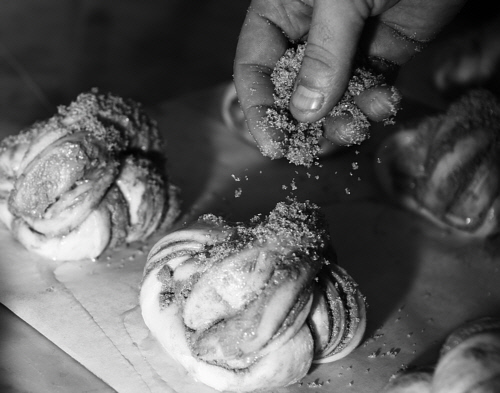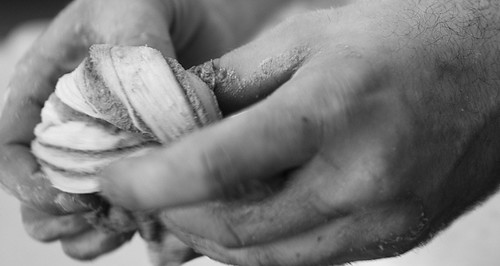Having passed the bakery and baker’s shop called Brødbakerne or The Bread Bakers in English to and from work in addition to buying their delicious products, it was finally time to pay them a visit. The occasion was a multimedia course where everyone had to conduct and record an interview together with taking photos.
The owner and founder, Jesper Pedersen, started his education as a baker when he was 15 and has been working with bakery products ever since. Having obtained his craft certificate and worked for some time in Denmark, he came to Norway in the early 2000s since there was more work available here. Since his cousin was working at Åpent bakeri, whose bakers have lifted the selection and quality of bread in Norway to a level not known here before, he was interviewed in the afternoon and started working there the next morning. Åpent bakeri has also educated a diverse range of highly skilled bakers who have gone on to to found bakeries in various places of Norway. Another highly skilled baker, the above mentioned Jesper, founded the bakery Brødbakerne at Jar in Oslo about 5 years ago together with another baker. In the beginning, they made breads which they brought to restaurants. However, due to their delicious bakery products, they also set up a baker’s shop next to their bakery in addition to founding another combined bakery and baker’s shop at Skøyen about 2 years ago. In fact, the name The Bread Bakers only tells part of the story since they also make pastries tasting so good that I have to force myself to avoid eating them or risk gaining weight. Having witnessed how they are making Danish pastries, adding sugar and vast quantities of butter to the dough, I think this is a wise choice.
The photos show how Danish pastries are made. After having made dough using sugar, flour, yeast and water, the dough is rolled flat and covered with a thick layer of butter, the dough is folded again before being rolled again by means of a machine. Folding and rolling the dough several times, in the end, layers of dough and butter will be on top of each other like the pages of a book with the dough also forming the cover. After cooling in order to slow down leavening, Jesper and his employee Vladimir from Estonia, cut up the dough in triangles, which they rolled into cylinders. After leavening, their products would be baked and be ready for sale in the shop located next to the bakery.
Vladimir also covered parts of the same dough with a thin layer of chocolate together with sugar. After having folded and rolled the dough, he cut it into rectangles, which he skillfully tied in knots before covering them with egg yolk together with a mix of sugar and cinnamon.
Having watched quite a few bakers and confectioners a work, I’ve always been impressed at their level of dexterity and all of them making it seem like their work is easy. However, I had to ask Jesper about what he felt about his work and I told him that my impression is that although they are doing more or less the same every day, their work will never be routine. Moreover, the ambient temperature and the humidity will also affect how they treat the dough. Yes, he told me, depending on the ambient temperature we have to cool the water on hot days, even adding ice cubes when we are making Danish pastries, while we may be using tepid water on cold days. Depending on the humidity, we also have to vary the baking time of our products. Although our customers think that our products are excellent, we can always detect changes and small defects, meaning that no two breads are alike, even though they are made from the same dough. Not to speak of bread made from two different doughs, which will always be different. Since their products are hand made, Jesper told me that he never feels like he has made perfect products and that he should always have improved something. For example, limited capacity in the ovens may lead to that their products won’t be baked immediately, while limited space leads to that the bakers have to wait for each other.
In addition to using water, flour, salt and yeast for their breads, their guiding principle is to let the making of their products take its time, meaning 6-7 hours from preparing the dough to a finished bread although this will vary in accordance with the type of bread.



